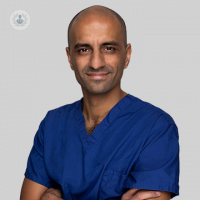Advances in atrial fibrillation ablation technology
Written in association with:In this detailed guide to ablation treatment for atrial fibrillation, revered consultant cardiologist and cardiac electrophysiologist Dr Saagar Mahida offers expert insight on how technological advances in the field continue to improve outcomes for patients suffering from this cardiac condition. The leading specialist and high volume practitioner of this form of treatment also sheds light on how catheter ablation was developed as a treatment for atrial fibrillation and how its use has become well established in the UK.

In 1998, Professor Hassaguerre and colleagues at Hôpital Haut-Lévêque, CHU Bordeaux performed the first curative catheter ablation for atrial fibrillation. This pioneering procedure revolutionized the treatment of atrial fibrillation. Over the past two decades, catheter ablation has become an established and effective treatment strategy for atrial fibrillation. More than 8,000 catheter ablation procedures have been performed in the UK annually in recent years, with Liverpool Heart and Chest Hospital being one of the highest volume ablation centres in the UK.
It is important to recognise that catheter ablation is only one side of the coin. An alternative option for the treatment of atrial fibrillation is medical therapy (antiarrhythmic drugs). When performed by experienced and appropriately trained operators, catheter ablation is safe and superior to antiarrhythmic drug therapy for maintenance of a normal heart rhythm. A discussion on the choice between ablation and antiarrhythmic drug therapy is available on my website.
The cornerstone of catheter ablation for atrial fibrillation involves pulmonary vein isolation. In the majority of patients with atrial fibrillation, the arrhythmia originates from the left top chamber of the heart, known as the left atrium. The left atrium is a heart chamber that receives blood from the lungs via four large veins, known as the pulmonary veins. An analogy is four large pipes (pulmonary veins) draining blood into a tank (left atrium). The abnormal impulses that trigger atrial fibrillation commonly originate from these veins. The aim of the pulmonary vein isolation procedure is to create lines of scar in the left atrium to block these abnormal impulses.
The field of catheter ablation for atrial fibrillation is evolving rapidly. Early catheter ablation procedures involved delivery of heat (radiofrequency) energy to effectively burn focal points of heart tissue. The points were joined together to create lines of scar. Point-by-point ablation remains a commonly used method for performing pulmonary vein isolation. While ablation catheter designs have evolved to allow more rapid delivery of heat energy and to measure how firmly the catheter pushes against heart tissue, the point-by-point approach is associated with longer procedure times.
In recent years, there has been significant interest in developing technologies that allow more efficient pulmonary vein isolation. Examples include catheter designs that allow simultaneous ablation around the entire circumference of the pulmonary veins (rather than point-by-point ablation). These ‘single shot’ technologies are gaining widespread traction. The types of energy used to achieve pulmonary vein isolation have also evolved, with the development of freezing technology and a technology known as pulsed field ablation.
Overall, your heart rhythm specialist will select technology based on your specific atrial fibrillation type and the anatomy of your heart. Experienced operators will tailor the ablation strategy to your specific circumstances.
In 2013 and 2014, Dr Mahida had the privilege to work under the mentorship of Prof Haissaguerre at Hôpital Haut-Lévêque, CHU Bordeaux. He has since established himself as a high-volume operator and uses cutting-edge catheter ablation technology in the UK. Dr Mahida performs a high volume of catheter ablation procedure and is involved in development of novel techniques and technologies to improve outcomes of catheter ablation.
Dr Mahida’s private practice is based at Spire Manchester Hospital, Spire Liverpool Hospital and the Rowan Suite at Liverpool Heart and Chest Hospital. If you wish to schedule an appointment with Dr Mahida, you can do so by visiting his Top Doctors profile.


